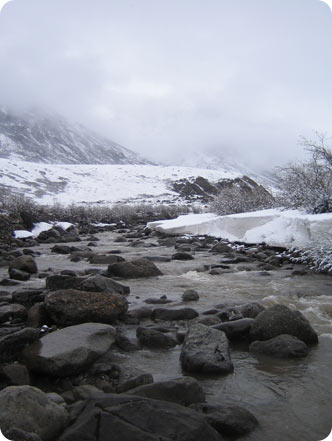Rivers pour hundreds of cubic miles of water into the Arctic Ocean every year. And over the last few decades, the flow’s been increasing by close to two cubic miles every year. That may not sound like much, but it adds up to a lot of extra fresh water.
 Spring snow melt in Alaska. Credit: Picture taken by J.W. McClelland.
Spring snow melt in Alaska. Credit: Picture taken by J.W. McClelland. That’s just one of the changes the Arctic Ocean has seen as a result of Earth’s warming climate. Over time, those changes could have an impact on the entire planet.
The Arctic is the world’s smallest ocean. Yet it receives about one-tenth of all the fresh water from the world’s rivers. Most of that comes from four great rivers in Russia, plus the Yukon and Mackenzie rivers in North America.
Most of the river water is added when the snow melts in spring. In recent decades, that’s been happening earlier in the year. The ice that covers the ocean has been breaking up earlier, too, and more of it has been melting each summer.
Those changes could lead to a change in the growth patterns of the tiny plants that form the first link in the ocean food chain. And that could lead to changes in ocean life throughout the entire Arctic basin.
The changes could also lead to changes around the globe. Much of the fresh water that enters the Arctic Ocean eventually moves into the Atlantic. Changes in the amount of water, as well as its temperature, salinity, and other factors, could change how water circulates through the Atlantic and other oceans. And that could alter global weather -- another consequence of Earth’s changing climate.
This episode of Science & the Sea was made possible by a grant from the National Science Foundation Office of Polar Programs.

